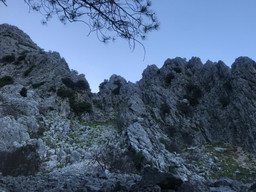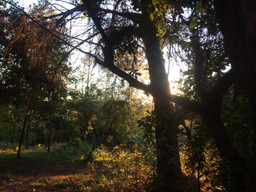
Learning to listen for nature field recording
With practice and attention, our ability to listen evolves over time. It’s determined by a range of factors, including our specific psycho-acoustic system; the shape of our ears, head, and torso; any hearing conditions; our cultural background; and our ability to cope with different sonic environments.
Below, I’ve answered some questions about listening, on the basis of my own experience as a field recordist. The answers should be useful for field-recording beginners, or anyone else who’s interested in exploring sound (with or without a recorder).
It’s not uncommon for ‘amplified listening’ (through headphones, in the field or subsequently, or through speakers) to increase the listener’s awareness of nuanced sonic textures, spaciousness, surfaces, and the different levels of various sources of sound. This can transform recordists’ day-to-day lives and reshape auditory perception.
Can amplified listening influence field recording and help us explore our own aesthetics?
My own relationship to listening has been developing over the years since I started to record. At the very beginning, I was fascinated by a full soundscape of birdsong or cowbells in a flat landscape; I was mostly perceiving soundscapes’ melodic aspects.
For another couple of years, I kept recording but didn’t really know what to listen for; that question wasn’t even present in my mind. My approach, then, was mainly technical: choosing a ‘good’ position for the microphone setup so I could capture ‘the landscape’. Something about the entirety of a soundscape – like a panoramic picture – plus the excitement of being outdoors, made me feel that I was discovering something (but I wasn’t: everything was already there).
Movement
In 2015–16, I was the audio engineer for a documentary shoot in a private nature reserve in Sweden. Back then, I don’t think I even knew what a dawn chorus was, so I set out to listen and record anything interesting I could find, avoiding any anthropophony.
To my innocent ears, nothing special was happening – until, one afternoon, I finally listened to the wind traveling from one tall pine to another on the opposite side of the site. I heard the wind in the first tree, shaking its branches and leaves, before, shortly after, it whirled up the second pine. I can only describe it as sounding like little papers being shaken and making different tonalities and sonic colors. So, what was this all about? Movement, sound moving! It created a very strong sensation of space.
At this time, I was working actively as a sound designer and the expansiveness of the environment I found myself in was a very attractive accompaniment for footage of a natural outdoor setting.
From a distance, I could also hear a number of mallards around one of the lakes on the reserve. The geographic spaciousness that was revealed through these sounds was amazing to my ears. The mallards were loud enough that the vast surface of the lake, with its surrounding forest, was shown by a long reverb, with a harsh timbre just like the mallard call.
Distinction
Fast forward to a project in the Atlantic Forest (Brazil, 2016) that I considered to be my first ‘big’ field recording trip, where I was immediately disheartened when I set out the gear.
I was expecting the tropical forests I used to see on TV, with that impressive sonic quality of shimmering reverberating bird song coming from trees with light shining between their leaves. But my expectations didn’t match reality.
In reality, the Atlantic Forest sounded flat. The dense vegetation – impenetrable in some places – was acting as a huge sound absorber, disrupting my fantasy of recording shimmering, mysterious birdsong in a tropical forest. It was only after several days of continuous recording that I came to understand what was happening and the source of my disappointment.
At this time, I wasn’t experienced enough to consider a different stereo recording technique, like a larger AB – recording setup (with two omnidirectional microphones in parallel), which could have helped meet my expectations of what I felt I should be able to capture in a recording. My mind had registered a very special sonic quality which occurs in films and nature documentaries, but which barely occurred in both locations I recorded in the Atlantic Forest.

So, I started to look for uneven spaces, and bodies of water, big rocks (scarce in the Atlantic Forest), or big trees that would become a distinctive sound source in this sonic environment. And, one day: on top of a hill, I found a big rock, overlooking the chilling sight of the nearby city eating up the forest, which made the birds’ chirps a little more special. Finally, they were much closer to the sounds I had been imagining in my mind’s ear.
My expectations had led to my initial disappointment. But at least I came to establish one aspect of natural soundscapes that strongly attracted me – the distinct reverberation of the acoustic space.
If recordings don’t live up to your expectations, does this make them worthless?
For some time I thought so, but now I disagree. Even if most of it sounded like a blanket of foliage, a recording will always include elements which make it worthwhile and pleasant to listen to.
This recording is one of my favorite examples. Definition and spaciousness are not the best terms to describe it, but the beautiful call of the solitary tinamou (a species of ground bird) makes it all worth it, doesn’t it? Also consider the fine texture of leaves and twigs, the slow rise and fall of the cicadas, and occasional other bird calls.
The wall of sound I encountered in the Atlantic Forest was a non-issue in my more recent work, such as Wolf Soundscapes. The sanctuary in Picão, Portugal, where I recorded this album was made up of hills with tree corridors, forest, and rocky open spaces. But I can’t overemphasize the stars of the show: Iberian wolves howling together. They would sound fantastic in any space, but the way their calls traveled through this particular geography enhanced the listening experience.
However, this seemingly beautiful scenario wasn’t without difficulties as I tried to make recordings and get the best out of this marvel. The wind simply changing direction could bring new issues, or relief; even from some kilometers’ distance, surrounding villages and roads could pollute my idea of a perfect recording.
One thing I ‘discovered’, though, was how strange it sounds to listen to two different tonalities coming from what each microphone was capturing. I’ll explain.

I was using the ORTF stereo recording technique (my favorite, which originated at the Office de Radiodiffusion Télévision Française circa 1960). In this technique, the two microphones are positioned non-coincidentally, though not too wide apart – making the differences between the left and right channels’ background sounds obvious. Imagine that far off on your right side is a loud stream, and on your left, a waterfall. Even though both are more or less a mash-up of frequencies, similar to white noise, they are still distinguishable from one another. But, even though my goal was to record the animals within the 44 acres (18 hectares) of the sanctuary, my brain was extremely confused by this. Was this because of my background as a sound designer, perfectionism, or the way I perceive and process sounds?
Either way, it led me to tweak, turn, and adjust the height of the microphone stand, and try all possible angles for the array, as well as searching the landscape for walls, trees, stones, or openings that could either block the undesirable sounds… or make the gear more susceptible to them. Was this a magic bullet? Absolutely not – this problem was mainly beyond my control! But it helped a bit. When necessary, more mitigation could be done in post-production. And yes, that meant long (long!) periods listening to kkksssshhhhhh sounds and playing with equalization until the recording sounded less confusing, but without spoiling the tonality of the main sound source.
So even though I had it logistically very easy – staying in a house in the sanctuary, where I could check my recordings every day in comfort – I learned so much from this project; it remains the most difficult one that I’ve experienced, in terms of the specifics of attaining high quality recordings. I’m also aware that, if this project had happened years earlier, I wouldn’t have noticed the issue of intrusive sounds; I guess the more you practice, the more you question.

Wind hazards
Wind can be tough. When it comes to field recording gear, I usually say that the best investment is wind protection. Even the most expensive mics and mixer can be ruined without appropriate wind protection.
I won’t debate the best or worst options, but I will share one example of self-inflicted ‘wind leaks’ in my gear. There is a difference between recording the sounds of the wind (not easy, by the way), and recording the undesirable distortion caused by the wind blowing across the capsules of the microphone, or entering the cage, or blimp, through a tiny slit.
If I place high quality, professional gear in a natural space, is that all it takes to make a good recording?
If you have good conditions, then, yes, probably. Maybe, if your gear is set up well in an ideal location, all you need to do is press ‘rec’. However, I believe that there is a difference between that and an approach that is specific to you.
There are nearly a dozen sound artist field recordists whose work I can listen to with my eyes closed and recognize, as with any other form of art, on the basis of a distinctive aesthetic approach. By tuning in to what you most appreciate in a soundscape and letting that guide you in your practice, in time you may be able to develop your own signature.
Featured photo by Ludgero Almeida: Melissa Pons in the Atlantic Forest
All photos courtesy of Melissa Pons
Earth.fm is a completely free streaming service of 1000+ nature sounds from around the world, offering natural soundscapes and guided meditations for people who wish to listen to nature, relax, and become more connected. Launched in 2022, Earth.fm is a non-profit and a 1% for the Planet Environmental Partner.
Check out our recordings of nature ambience from sound recordists and artists spanning the globe, our thematic playlists of immersive soundscapes and our Wind Is the Original Radio podcast.
You can join the Earth.fm family by signing up for our newsletter of weekly inspiration for your precious ears, or become a member to enjoy the extra Earth.fm features and goodies and support us on our mission.
Subscription fees contribute to growing our library of authentic nature sounds, research into topics like noise pollution and the connection between nature and mental wellbeing, as well as funding grants that support emerging nature sound recordists from underprivileged communities.
